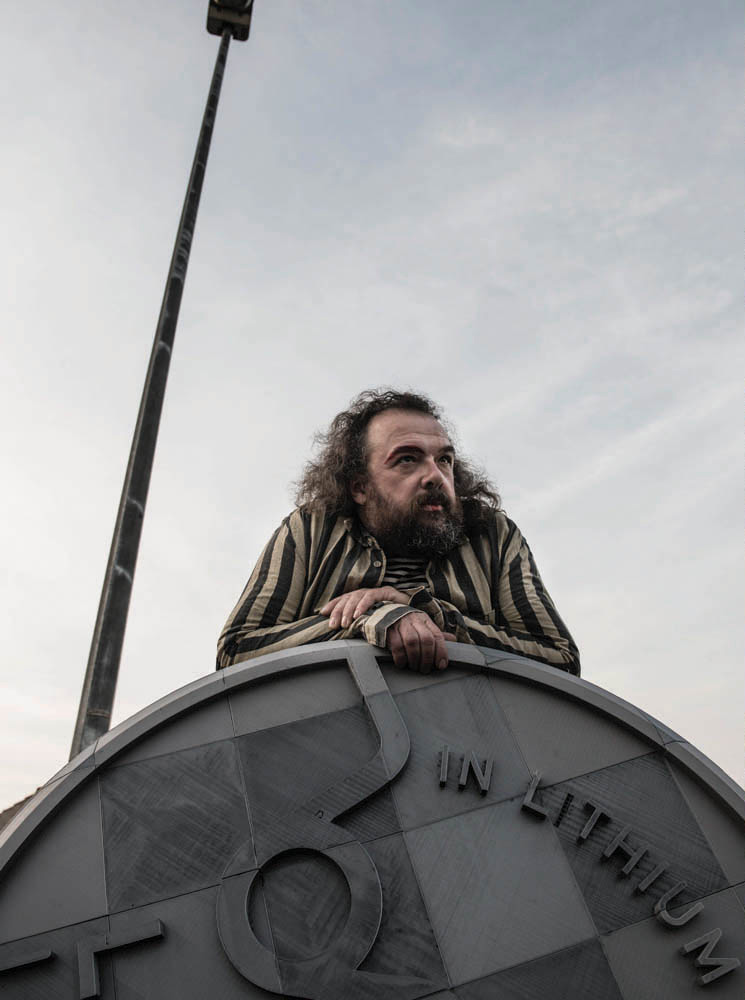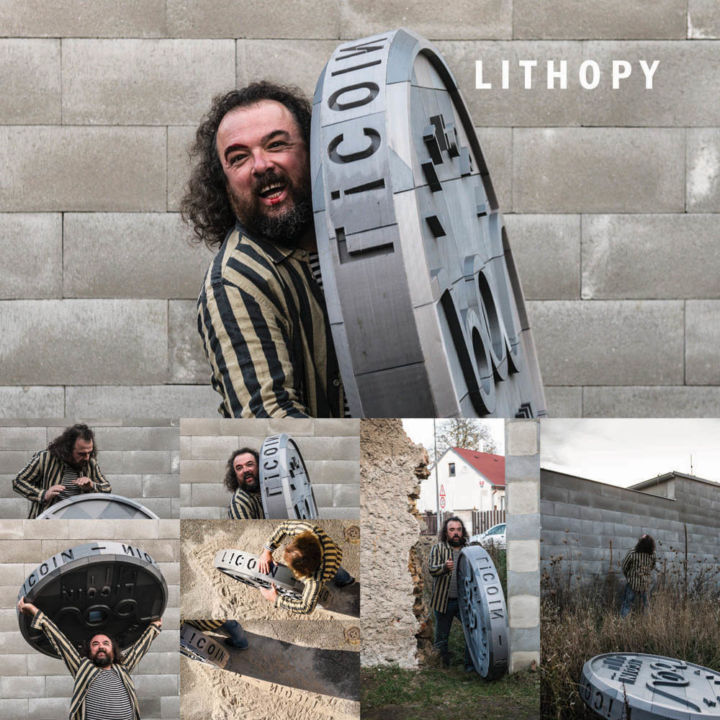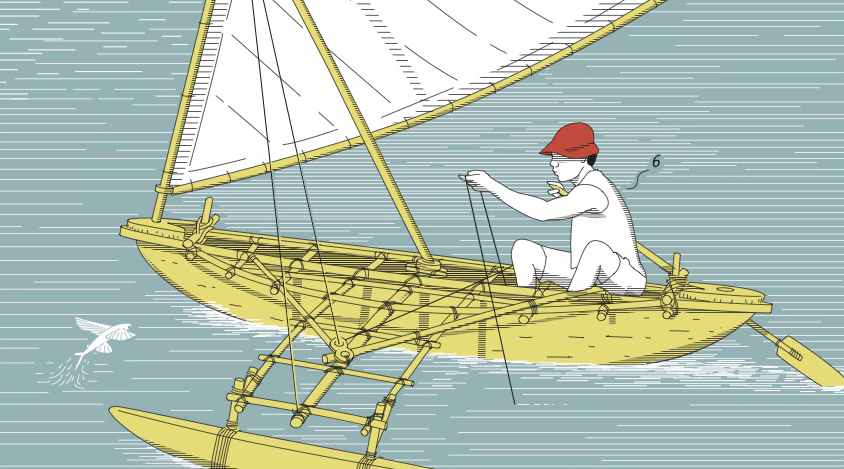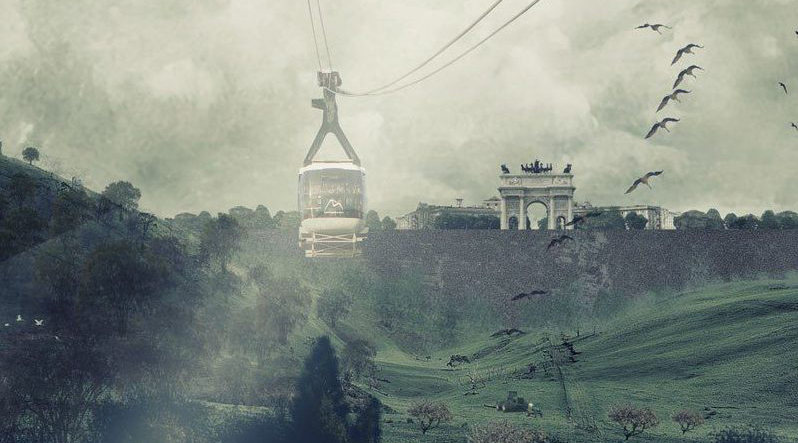EDITOR’S NOTE: Lithopy, curated by Denisa Kera and Petr Šourek along with a second project entitled Out of Power Tower, represents the Czech participation in the XXII Triennale di Milano, Broken Nature. The projects arise from a survey centered on the significant mineral resources of the Czech territory––in particular, lithium. Lithopy questions the practice of this mineral’s extraction and its use. The Czech pavilion was commissioned by the Museum of Decorative Arts in Prague with the Ministry of Culture of the Czech Republic.

Lithopia Design Fiction movie scene.
The Lithopia Project1 offers a design method for anticipatory governance7 of emerging blockchain and DLTs that goes against the current hype of anticipatory and frictionless design promises of full control over user decisions2,11. Instead of predicting user needs that ultimately serve one version of the (industry defined) future, anticipatory prototyping involves the users as stakeholders in the adoption of the emerging technology. It offers templates of blockchain services that present the future scenarios and dilemmas, which can be modified and iterated to support inclusive and democratic “future-making”14,15 that combines prototyping with deliberation.
The Lithopia prototyping templates consist of a dashboard featured on Figure 1 and a design fiction scenario (Figure 2 and 3). While the dashboard integrates the existing social and technical infrastructures (social institutions of marriage and property ownership on the ledger with data from satellites, Hyperledger Fabric REST API, and various open APIs), the design fiction presents exaggerated and artistically rendered use cases that hint at the potential (mis)uses. In this fictional village, some common gestures have unexpected meaning if caught by satellites, and the Lithopians are forced to invent bizarre strategies of hiding under umbrellas to escape their satellites and the blockchain. They also indulge in various techno-superstitions, such as horoscopes of satellite locations, which they use to interpret geopolitical events.
The scenarios are intentionally ambiguous and exaggerated to provoke creative uses of the Lithopia templates on the Github. In the Lithopia context “Sunny days are made for transactions. No clouds prevent satellites from keeping an eye on contracts being made and assets changing hands. People exchange goods, make payments, marry and divorce. All the hustle and bustle of sunny days is recorded by the decentralized digital ledger of the blockchain. Hugs are big and kisses are many to make sure satellites recognize and the blockchain records affection, love, and friendship. In Lithopia, all social contact is a smart contract.”8

Anticipatory prototyping
The Lithopia project serves as an educational tool, but also a participatory probe to critically evaluate the promises of DLTs’ future, in which governance will merge with automation over smart contracts, and we will have a tool to control data tempering, fake news, or even AI simulations. The anticipatory prototypes explicitly connect design with ethical deliberation and policy negotiations by engaging the public directly in the design process rather than predicting user behavior and promising “anticipatory” design.
The prototypes utilize existing open source tools (Hyperledger Fabric and Composer for the blockchain contracts; Node-RED and various open APIs for the dashboard) to create templates on GitHub that support creative and exploratory uses of such technologies. The goal is to help the general public and various stakeholders to understand, experience, experiment with, and deliberate upon the future of blockchain and its integration with other existing technologies.
Blockchain governance and design
While the first decade of blockchain and DLTs was mainly on transactions between humans (Bitcoin blockchain and numerous crypto-alt-currency projects), we are entering a phase that emphasizes integration of these emerging technologies with existing infrastructures and corporate and institutional actors (Ethereum, Ripple, and Corda platforms and protocols) along increasing machine-to-machine transactions, including AI and IoT scenarios (IOTA). The original, libertarian, and crypto-anarchist emphasis on privacy and anonymity of the individuals is transforming into a pragmatic search for convergences of the DLTs with existing social, but also technological, infrastructures (satellites, IoT, banks, and supply chains)4,13 .
This rapid development brings technical, but also policy and ethical challenges that are usually ignored by the design community and outsourced to policymakers after significant scandals. Paradoxically, the technology whose sole purpose is to create a trust and record system for smart (automated) contracts and novel forms of collaboration and exchange still resists attempts to involve various stakeholders in defining standards and rules12. Instead of policy coordination (with a rare exception of the ITU-T Focus Group on Application of Distributed Ledger Technology), the preferred form or communication with the public and other stakeholders remains the “demo” and “white papers.” Furthermore, there is also a danger of “promissory futures”9 and “sociotechnical imaginaries”1 that follow every emerging technology and create the fantasy of predictive and anticipatory design.
The Lithopia project offers an alternative to the predictive and anticipatory design calls for push-design patterns and frictionless interaction5.16 with a proposal for anticipatory prototyping that explicitly looks for convergence between prototyping and policy through stakeholder engagement in “future-making.”4,15,3 The project combines participatory design methods with ethical deliberation and issues of anticipatory governance. It involves the human participants as stakeholders through role-playing and simulation where they provide feedback and also iterate with the templates.
Through prototyping workshops and stakeholder panels, they document the prototypes and their uses, and then collectively define future scenarios in a given domain identifying the potential threats and issues for further policy assessment and design considerations.
Lithopia dashboard and design fiction
The Lithopia project uses functional, hyperedge-based prototypes of smart contracts to tell a story about a small Czech village, in which the villagers consciously use gestures, rituals, and visual triggers in front of satellites and drones to confirm transactions (marriage, selling of property, adding someone as a friend). The project was commissioned for the Czech national pavilion for the XXII Triennale di Milano called “Broken Nature: Design Takes on Human Survival.” It brought together various practitioners (developers, academics, actors, theater director, and a philosopher) through several workshops and meetings between June 2018 till February 2019, to explore how design can support accountability, community building, infrastructure integration, and define strategies to involve the general public and various stakeholders in the early development of new technologies.
The cooperation resulted in several prototypes (templates) and a 10-minute design fiction movie presented as a seven-channel multiscreen installation showing in parallel what is happening on and in the earth/village (Lithopians acting), sky (satellites and APIs data) and the blockchain (the code and the logic of transactions). It follows several stories involving gossiping, marriage, infidelity, and property sales in the fictional village of Lithopia.
The team is continuously documenting the functional prototypes, which include one of the first uses of satellite image data to trigger a smart contract on the Hyperledger platform by using a visual trigger on the ground in the form of an area covered with bright red textile. We covered an area with a 10 x 10 m textile as a cue for the image recognition programme “Lithopia scanner” to signal the fictional sale of a property (balcony). For this, we use real-time satellite images from the Copernicus Sentinel system (10 x 10 m is a standard pixel for Sentinel-2A and 2B satellites).
The assets and relationships in Lithopia are managed via a personal dashboard created on the Node-RED platform that connects the data from the Hyperledger REST API server with the data from the satellite and various open API systems (prices of cryptocurrencies, the location of the satellite, etc. ). Currently, Lithopians can buy and sell their real and virtual assets and also marry and partner with one or more people via the contracts on the Hyperledger Fabric blockchain.All the prototypes are open-source and reusable for real projects. We describe them as templates and plan to use them in future workshops documenting the whole process on the Github page. The Hyperledger contracts currently exist as a code and a REST API server (Lithopian business network and JS logic testable on Hyperledger Composer and Fabric). The Node-RED flows for the dashboard are documented on GitHub, but we plan to give access to the programming interface in the workshops. For the analysis of the satellite data, we developed the “Lithopian scanner” tool that identifies colors in specific areas and sends the data to Hyperledger, but can be used as API also for other projects).
In the design fiction, we hint at the possibility of gesture-based triggers in front of drones or satellites with better resolution than Sentinel, but we have not tested such interactions. Aesthetically, we are still interested in such long gestures as triggers but also in a type of ritual or dance in front of the satellites and the blockchain that embodies the motto on the dashboard: “It’s a new day under the starry satellites above and the moral law within the distributed ledgers.” We plan to push this interaction between blockchains and satellites even further into land art and dance performances as triggers of smart contracts. The connection of earth and the sky over such rituals performed in front of satellites and blockchains connects present-day applications with old traditions, which is a direction we want to explore to make the emerging technologies more accessible to the general public and different stakeholders.


Lithopia project is a test of an anticipatory prototyping framework that combines participatory design methods with ethical deliberation and issues of anticipatory governance to research blockchain and DLTs. The project involves users as stakeholders through role-playing to prototype and provides feedback related to a design fiction movie and a set of templates. Through prototyping workshops and stakeholder panels, they document the process and collectively define future scenarios to identify the potential threats and issues for further policy assessment and design considerations of blockchain and DLTs. The goal of anticipatory prototyping is to imagine and anticipate various futures in the mundane and everyday activities, which we also connect to old rituals and traditions. The templates serve anticipatory prototyping and future-making that integrate blockchains and DLTs with existing social and technical infrastructures. The goal is not only to educate the public and the various communities about these emerging technologies but also to offer tools to develop ideas and visions for these technologies.
1 Ulrike Bechtold, Daniela Fuchs, and Niklas Gudowsky. 2017. Imagining socio-technical futures – challenges and opportunities for technology assessment. Journal of Responsible Innovation 4, 2: 85–99.
2 Joël van Bodegraven. 2017. How Anticipatory Design Will Challenge Our Relationship with Technology. 2017 AAAI Spring Symposium Series, AAAI Spring Symposium Series.
3 Kristian. Borch, Sandra M. Dingli, and Michael. Søgaard Jørgensen. 2013. Participation and interaction in foresight : dialogue, dissemination and visions. Edward Elgar.
4 Brett Scott. 2016. How Can Cryptocurrency and Blockchain Technology Play a Role in Building Social and Solidarity Finance? | Events | UNRISD.
5 Jerry Cuomo and Robert Vila. 2013. Mobile Design Patterns: Push, Don’t Pull.
6 Rider W. Foley, Michael J. Bernstein, and Arnim Wiek. 2016. Towards an alignment of activities, aspirations and stakeholders for responsible innovation. Journal of Responsible Innovation 3, 3: 209–232.
7 David H Guston. 2014. Understanding ‘anticipatory governance.’ Social Studies of Science 44, 2: 218–242.
8 Denisa Kera. Github Lithopia contract. Retrieved from hiips://github.com/anonette/lithopia.
9 Michael Morrison. 2012. Promissory futures and possible pasts: The dynamics of contemporary expectations in regenerative medicine. BioSocieties 7, 1: 3–22.
10 Christen O’Haire, Melissa McPheeters, Erika Nakamoto, et al. 2011. Descriptions of Stakeholder Engagement Methods.
11 Victoria Sgarro. 2019. The tyranny of frictionless design – UX Collective. UX Collective. Retrieved February 7, 2019 from hiips://uxdesign.cc/the-tyranny-of-frictionless-design-1325ab14432c.
12 Vili Lehdonvirta. 2016. The blockchain paradox: Why distributed ledger technologies may do little to transform the economy. Oxford Internet Institute blog.
13 Aaron Wright and Primavera De Filippi. 2015. Decentralized Blockchain Technology and the Rise of Lex Cryptographia. Retrieved July 27, 2017 from hiips://papers.ssrn.com/sol3/papers.cfm?abstract_id=2580664.
14 Susan Yelavich. Design as future-making.
15 Susan Yelavich and Barbara Adams. 2014. Design as Future-Making. Bloomsbury Publishing.
16 Victoria Young. Strategic UX: The Art of Reducing Friction. Telepathy. Retrieved February 7, 2019 from hiips://www.dtelepathy.com/blog/business/strategic-ux-the-art-of-reducing-friction.



